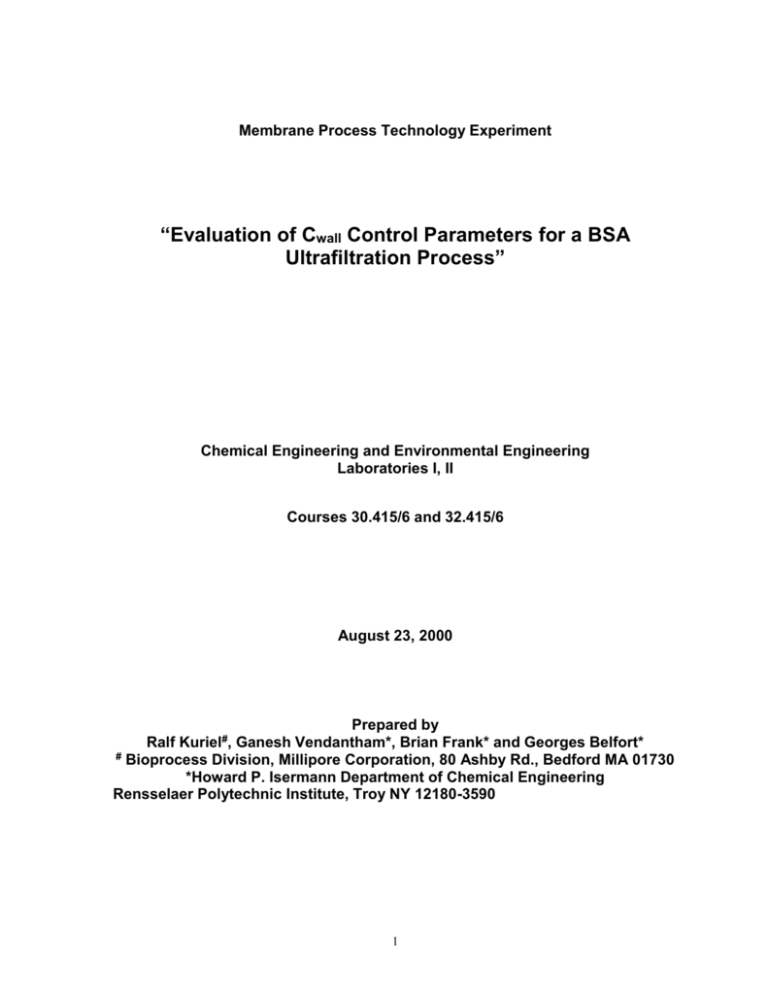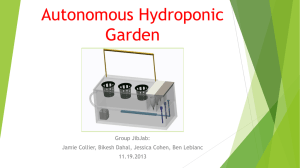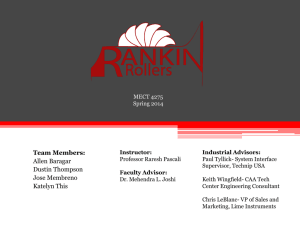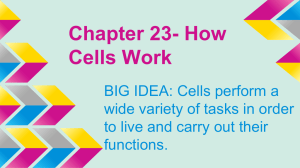Membrane Manual - Rensselaer Polytechnic Institute
advertisement

Membrane Process Technology Experiment “Evaluation of Cwall Control Parameters for a BSA Ultrafiltration Process” Chemical Engineering and Environmental Engineering Laboratories I, II Courses 30.415/6 and 32.415/6 August 23, 2000 Prepared by Ralf Ganesh Vendantham*, Brian Frank* and Georges Belfort* # Bioprocess Division, Millipore Corporation, 80 Ashby Rd., Bedford MA 01730 *Howard P. Isermann Department of Chemical Engineering Rensselaer Polytechnic Institute, Troy NY 12180-3590 Kuriel#, 1 OBJECTIVE: Evaluation of Cwall control parameters for a BSA ultrafiltration process. 1 INTRODUCTION 1.1 Objectives [1] [2] [3] [4] [5] [6] 1.2 Learn the fundamental concepts of mass transfer in a pressure driven membrane ultrafiltration of an important blood protein, bovine serum albumin. Obtain the membranes’ water permeability (control). Use the membranes to perform protein diafiltration at two concentrations, measuring the effect of transmembrane pressure on flux. Determine Cwall parameters from the experimental data using both the osmotic pressure model and the stagnant film model. Test the models with the experimental data by using the experimentally determined parameters. Understand why optimizing BSA ultrafiltration through control of Cwall is an attractive strategy. Background Pressure-driven synthetic membrane processes are being increasingly integrated into existing reaction and recovery schemes for the production of valuable chemical and biological molecules. The properties of these membrane systems that are most often exploited are their operation without a phase change, without a temperature excursion from ambient, without need for additives and with relatively low energy consumption. The ultrafiltration process (membranes with molecular weight cutoff between 2 and 1000 kDa or pore size between 1 and 100 nm) normally operates with a constant transmembrane pressure or a constant permeate flux. Both fundamental and practical considerations suggest, however, that UF processes should be controlled by maintaining a constant Cwall of fully retained solutes. van Reis et al., (1997) have developed a Cwall control strategy in order to minimize protein sieving, solubility and adsorption losses as well as optimize time and area. Implementation of this technology, however, requires the knowledge of what are known as the C wall control parameters. The objective of this lab is to perform experiments which will result in estimating Cwall control parameters for a bovine serum albumin (BSA) ultrafiltration process. NOTE: The four students in a lab group are split into two pairs of students. Each pair will operate one apparatus. One group will use BSA concentrations of 2 and 5 g/l. The other pair will use BSA concentrations of 3 and 6 g/l. Therefore, each pair of students in a group makes five sets of flux measurements, using deionized water, protein solution of a lower concentration, buffer solution, protein solution of a higher concentration, and buffer solution again. The data will be combined for 2 analysis. This way, if one set of data at a particular concentration is not suitable for analysis it can be discarded. NOTE: Please read the first 10 pages of van Reis et al., (1997) carefully. You need to understand how to estimate the Cwall control parameters after performing the required experiments. A brief description of the procedure is presented in the Appendix. 3 2 NOMENCLATURE J PFEED PRET PPERM p or TMP pAxial Cb Cwall Lp Lfm k 3 Permeate flux (LMH). Feed pressure (psi). Retentate pressure (psi). Permeate pressure (psi). Transmembrane pressure (psi) = [(PFEED + PRET)/2 - PPERM]. TMP is the average of the PFEED and PRET gauges. Be prepared to explain why during your prelab. Axial pressure drop (psi) = [PFEED - PRET]. pAxial is the difference between the PFEED and PRET gauges. Be prepared to explain why during your prelab. Osmotic pressure (psi). Bulk protein concentration (g/l). Protein concentration at membrane surface (g/l). Permeability of clean membrane (LMH/psi) (JINITIAL/p). Permeability of fouled membrane (LMH/psi) (JFOULED/p). Mass transfer coefficient (LMH). EQUIPMENT The equipment consists of two main items: (i) a Pellicon™ XL membrane device (it houses a 30 kDa regenerated cellulose ultrafiltration membrane) [Figure3.1] and (ii) a Labscale™ Tangential Flow Filtration (TFF) system for operating the membrane process [Figure-3.2]. A labeled schematic of the Labscale reservoir setup is shown in Figure-3.3. Pellicon™ XL membrane contains membranes with a porous plastic screen (called a “turbulence promoter”) inserted between each membrane to give it rigidity and to induce mixing at the membrane-solution interface. Their total active transport area is Am = 50 cm2. Regenerated cellulose membranes exhibit very low protein adhesion. Note that (l/m 2-h) is shortened in the literature as “LMH”. Also, in analyzing the results we should not mix units (English and SI), so take your data in pressure units of psi but then convert them to KPa when you begin your analysis. 4 EXPERIMENTAL SECTION 4.1 Precautions [1] Proteins are exquisitely folded linear molecules and need to be treated gently and with care as they are fragile and can easily denature or unfold (e.g. pour protein solutions down the side of the reservoir; do not make foam as air will denature the protein). The protein chosen for this experiment is bovine serum albumin (BSA, from cows) and is harmless. Albumin is the most abundant protein in human plasma constituting about 50 % (4 g/100 ml) of the plasma proteins. Albumin has a molecular weight of ca. 68 kDa, an isoelectric point of ca. 4.8 (i.e. the pH at which the molecule is net neutral) and a free solution 4 [2] [3] 4.2 diffusivity of 6.1 x 10-7 cm2/s at infinite dilution. Albumin carries, at a maximum, 10 molecules of fatty acids in the blood to energy deficient tissues where the fatty acids diffuse from albumin to the tissues (ref.: G. Zubay, Biochemistry, McMillan Publ., New York, pp. 601-602, 1988). The regenerated cellulose ultrafiltration membranes are sensitive to applied pressure and can burst at pressure above 45 psi, so be sure to never exceed this maximum transmembrane pressure. Never use tap water as it contains suspended matter that could permanently plug the membranes. Materials [1] DI Water: DI water can be obtained in the water carrier stored on the shelf above the membrane apparatus. The DI water tap is in a white plastic sink located in the 3rd floor hallway of the Ricketts Building. It will be used for flushing the system, for measuring the permeability of the membrane before protein filtration and for measuring the permeability of fouled membrane. [2] Phosphate Buffer Saline (PBS): To prepare 0.00155 M PBS, add 0.0115 g of sodium phosphate dibasic, 0.0748 g of sodium chloride, 0.0003 g sodium phosphate monobasic and 0.0002 g of potassium chloride to 1 liter of DI water. [3] Protein Solutions: To prepare 2 g/l (or 3, 5, and 6 g/l) of BSA solution, add 0.4 g of BSA (or 0.6, 1.0, and 1.2 g BSA) to 200 ml of PBS buffer prepared above. Allow the solutions to mix by diffusion – do not agitate them (see 4.1 [1] above). Fig-3.1 Pellicon XL 50 cm2 device 5 Fig-3.2 Labscale TFF system Fig-3.3 Labscale 500 ml reservoir setup 6 4.2 Methods 4.2.1 System Cleaning without Pellicon XL Installed NOTE: The system has to be cleaned with DI water before any operation with membranes. [1] [2] [3] [4] [5] [6] [7] [8] Disconnect retentate tubing from RET IN port and place in waste collection vessel. Figure-4.1 shows system cleaning setup for steps [1] to [6]. Make sure tank outlet valve is open. Remove reservoir cover and fill the reservoir with 500 ml of DI water. Make sure plug is removed from VENT port and open tank outlet valve. Open the retentate back pressure valve fully. Turn pump on – set pump speed to 2. NOTE: Check system for leaks – tighten connections if required. Continue pumping to the waste collection vessel until the level in the reservoir drops to 250 ml. Turn pump off. Reconnect the retentate tubing to the RET IN port. Turn pump on and set pump speed to 2. Figure-4.2 shows system cleaning setup for steps [7] and [8]. Recirculate for 5 minutes. Turn pump off. Fig-4.1 Setup for cleaning system steps [1] to [6] Fig-4.2 Setup for cleaning system steps [7] & [8]. 7 4.2.2 Drain System [1] [2] [3] [4] [5] Disconnect pump outlet tubing from pump outlet port and place in waste collection vessel. Figure-4.3 shows system draining setup for steps [1] to [3]. Disconnect retentate tubing from RET IN port. Fluid should now drain by gravity. If additional drainage is required, a syringe can be placed on the end of retentate and fluid can be blown out. The reservior is drained in steps [4] and [5]. Replace retentate tubing in retentate port. Reconnect pump outlet tubing. Disconnect pump outlet tubing from FEED IN port and place in collection vessel. Make sure tank outlet valve is open, turn pump speed up to drain reservoir. Figure-4.4 shows system draining setup for steps [4] and [5]. Reconnect the pump outlet tubing to the FEED IN port. Fig-4.3 Setup for draining system steps [1] to [3] Fig-4.4 Setup for draining system steps [4] & [5]. 8 4.2.3 Flushing Device [1] [2] Remove plug from FEED, RET, PERM1 and PERM2 ports. Figure-4.5 shows Pellicon XL Device installation (steps [1] and [2]). Align Pellicon XL device ports with Labscale 500 ml reservoir ports being sure that PERM and RET ports of device and reservoir match. Press device firmly onto reservoir ports. Turn the lock nuts until snug. Fig-4.5 Install Pellicon XL device [3] [4] [5] [6] Disconnect the retentate tubing from RET IN port and place end of tubing in waste collection vessel. Figure-4.6 shows installation for flushing Pellicon XL Device (steps [3] to [7]). Place end of permeate tubing into waste collection vessel. Open retentate valve – turn counterclockwise. Remove reservoir cover and fill reservoir with 200 ml of DI water. Remove plug from VENT port and make sure tank outlet valve is open. Turn pump on – increase pump speed until feed pressure gauge reads 20 psi. NOTE: Check system for leaks – tighten connections if required. 9 [7] Continue pumping to the waste collection vessel until level in the reservoir drops to 100 ml. Turn pump off. [8] Reconnect the retentate tubing to RET IN port and turn pump on – increase pump speed until feed pressure gauge reads 20 psi. Figure-4.7 shows installation for flushing Pellicon XL Device (steps [8] to [10]). [9] Adjust retentate valve restriction by slowly turning the retentate valve clockwise until the retentate pressure gauge reads 10 psi. [10] Adjust pump speed and retentate valve to achieve 30 psi feed pressure and 10 psi retentate pressure. Continue flushing until reservoir drops to 10 ml. Fig-4.6 Flushing the Pellicon XL device steps [3] to [7] Fig-4.7 Flushing the device steps [8] to [10] 4.2.4 Drain System Refer to section 4.2.2 4.2.5 DI Water Permeability Test [1] Connect the permeate outlet to the recirculation (DIA/RECIRC) port. 10 [2] [3] [4] [5] [6] Remove reservoir cover and fill reservoir with 100 ml of DI water. Remove plug from VENT port and make sure tank outlet valve is open. Open tank outlet valve and adjust pump speed and retentate valve and measure the water permeate flux at the following transmembrane pressures: 35, 30, 20 psi (in that order). Maintain a constant pAxial of 10 psi. NOTE: Never exceed a transmembrane pressure of 45 psi. It may blow the system. Permeability is measured by a volumetric cylinder and stop watch. To measure the permeate flux, disconnect the permeate outlet from the recirculation (DIA/REC) port. The system is now set us as shown in Figure-4.7. Take one measurement at each of the transmembrane pressures by collecting permeate, then reconnecting the permeate outlet to the recirculation (DIA/REC) port and returning any collected permeate to the reservior. Instead of wating for a specified time period to allow equilibration, measure the permeate flux about every two minutes. At each measurement, use a convenient period of time to get about 10 mL. When you have three consecutive measurements whose standard deviation is less than 5% of the average of the three readings, then you may consider the system to be at equilibrium. The three readings may then be averaged for further use and their standard deviation used for error analysis. If you do not have three acceptable readings after 10 minutes, see a teaching assistant for advice. Drain the system. Plot the water flux through the membrane in LMH versus the transmembrane pressure in psi. Show the graph to your TA for approval and report the flux value at a transmembrane pressure of 35 psi. 4.2.6 Protein Fouling at low protein concentration (2 or 3 g/l BSA) [1] [2] [3] [4] [5] Gently pour the protein solution into the reservoir (see 4.1[1]). Connect the permeate outlet to the recirculation (DIA/RECIRC) port. Make sure tank outlet valve is open and adjust pump speed and retentate valve so as to obtain a transmembrane pressure of 10 psi and pAxial of 10 psi. Continue pumping for 5 minutes Note: This operation fouls the membrane and stabilizes the system. Measure permeate flux of the solution at a series of transmembrane pressures: (p = 20, 30, 35 psi). The axial pressure drop (pAxial) is maintained constant at 10 psi throughout the operation. Permeate flux is measured by a volumetric cylinder and stop watch. To measure the permeate flux, disconnect the permeate outlet from the recirculation (DIA/REC) port. The system is now set us as shown in Figure4.7. Take measurements at each of the transmembrane pressures by collecting permeate. Take measurements as for the water flux in section 4.2.5 step [4]. Then reconnect the permeate outlet to the recirculation (DIA/REC) port and return any collected permeate to the reservior. Drain protein solution and turn off the pump when done. 11 4.2.7 Fouled Membrane Permeability after first protein solution Repeat section 4.2.6, steps [1] to [5] with buffer solution. 4.2.8 Protein Fouling at higher protein concentration (5 or 6 g/l BSA) Repeat section 4.2.6, steps [1] to [5] with the higher protein concentration solution. 4.2.9 Fouled Membrane Permeability after second protein solution Repeat section 4.2.6, steps [1] to [5] with buffer solution. 4.2.10 Shutdown [1] [2] [3] [4] [5] [6] [7] Remove reservoir cover and fill reservoir with 500 ml of DI water. Ensure vent port is open. Make sure tank outlet valve is open. Turn pump on – increase pump speed until feed pressure gauge reads 20 psi. Adjust retentate back pressure valve and pump speed until a transmembrane pressure of 20 psi and an axial pressure drop of 20 psi is achieved. Recirculate the DI water for 5 min. Turn pump off. Drain the reservoir. Remove reservoir cover and fill reservoir with another 500 ml of DI water. Repeat steps [2] through [6]. 4.2.11 Drain System Refer to section 4.2.2 When done, plug the ports on the system and on the membrane module. 4.2.12 Clean Base [1] [2] [3] Clean all spills during the experiments. Clean all the bottles, beakers and graduated cylinders used in the experiment with Tergazyme™ detergent (not Alconox™). The Tergazyme™ is stored on the shelf above the membrane apparatus. When finished with detergent, wash all containers thoroughly with deionized water so that no residue of detergent remains. NOTE: If all detergent is not rinsed off your glassware it will cause severe problems for the next lab group. If this occurs, the TAs will find out and you will be penalized! References [1] [2] van Reis, R., Goodrich, E.M., Yson, L.N., Whitley, R., Zydney, A.L, Constant Cwall Ultrafiltration Process Control, J. Membr. Sci., 130, 123-140 (1997). Operating Instructions, Labscale™ TFF System, Millipore BioProcess division, Millipore corporation, Bedford, MA USA. 12 Appendix: Cwall Parameter Determination A novel methodology, developed by van Reis et. al., (1997) was used to evaluate Cwall parameters for BSA ultrafiltration (UF) process. A single UF experiment was required to determine all the parameters. The experiment involved a diafiltration step at a bulk concentration of 1 g/l, a concentration step from 1g/l to 4 g/l and a diafiltration step at 4 g/l. Conditions were chosen so as to maintain a constant axial pressure (pAxial) drop during the entire experiment. For the purpose of these experiment a totally retentive membrane was used. The Pellicon™ XL module consists of two flat sheets of 10 kD Biomax™ membrane. The conditions (pH = 7.4 and I = 0.155 mM) were chosen in order to minimize ant sieving losses of the protein. Two very commonly used models are utilized to compute the parameters. They are the osmotic pressure model (eq. 1) and the stagnant film model (eq. 2) and a three-coefficient virial-type expansion was used to relate the osmotic pressure to wall concentration (eq. 3). J = Lp(p - ) (1) J = k ln(Cw/Cb) (2) = Cw + Cw2 + Cw3 (3) Permeate flux data obtained under diafiltration conditions are plotted as a function of transmembrane pressure (p) at the two bulk concentration: J = f(p, Cb) (4) The fouled membrane permeability was determined by measuring DI water permeability after filtration and by osmotic pressure model: Lfm = J/p (5) The permeate flux data obtained with protein solutions are then used to calculate by rearranging eq. (1) as: = p – (J/ Lfm) (6) The data set defined by eq. 4 is recalculated using eq. 6 to yield a new data set as defined: J = f(, Cb) (7) 13 Now, each vertical line of the plot of flux versus osmotic pressure corresponds to a particular wall concentration of protein, as the osmotic pressure is a function of wall concentration only. The film model is used to calculate the mass transfer coefficient from the above plot at different wall concentration as: k = (J2 – J1)/(lnCb1 – lnCb2) (8) The mass transfer coefficients obtained at different wall concentrations were averaged out and was used to determine the wall concentration by rearranging eq. 2 as: Cw = CbeJ/k (9) This gives us a new data set of wall concentrations as a function of the osmotic pressure. Now, the virial coefficients can be calculated by rearranging eq. 3 as: / Cw = + Cw + Cw2 (10) This gives us all the parameters required to control an ultrafiltration process by maintaining a constant wall concentration. Once these parameters have been determined, they can be used to test the models with the experimental data. The parameters are: , , k and Lfm . 14 Mass Transfer Correlations To get k Sh = ReaScb Table 1 Mass Transfer Coefficient Correlations Conditions Laminar tube Laminar slit Developing Turbulent Turbulent Spacer Stirred cell Rotating Cooney [11] a b Correlation 0.33 0.33 0.50 0.80 0.875 0.50 0.567 0.50 0.33 0.33 0.33 0.33 0.25 0.33 0.33 0.33 c 0.33 0.33 0.50 0.50 0.42 1.62 1.86 0.664 0.023 0.023 0.664 0.23 0.75 Approach Theoretical Theoretical Theoretical Momentum, heat Theoretical (eddy model) Flux experiments Mass transport Flux experiments Leveque [4] Leveque [4] Grober et al [8] Chilton-Colburn [6] Deissler [9] DaCosta et al [7] Smith et al [10] Holeschovsky and *taken from Zeman and Zydney, MF&UF, Marcel Dekker Inc. 1996. dh = cross - sectional area available for flow wetted perimeter of the channel (24) 4 dh = (25) 2 (1 )s h where s = surface area ; unit volum e For a mesh (spacer) s= 6 (sphere) d s 4 (tube) d s 5 d 15 Independent Estimation of Mass Transfer Coefficient, k for Flow in a Straight Duct Step 1: Check flow conditon: laminar or turbulent flow d u if Re = Re > 1,800 < h < 1,800 Laminar flow, dh = 4rh = dm 2,100 Turbulent flow Re < 2,100 Intermediate flow Step 2: Use well known correlations to estimate k in correct flow regime dh L c Sh = Rea Scb Sh = Re = Sc = L = channel length (usually), cm D = diffusion coefficient of BSA ~ 10-6 cm2/s dh = hydraulic diameter (see previous page) = fluid density = dynamic viscosity, gm/cm-sec (1) kd h D ud D = the Sherwood number or the dimensionless mass transfer coefficient h = the Reynolds number = the Schmidt number Where 16 For Pellicon XL from Millipore Corp. with one feed channel filled with a spacer Q Axial Interstitial Velocity: u= =U (1) A where A = cross-sectional area for crossflow in the channel, cm2 = free fractional volume (porosity), - Q = volumetric flow rate, ml/sec. w h Flow out of channel Flow into membrane channel Permeate through membrane Spacer H = height = 0.020" = 0.508 mm w = width = 0.85" = 21.6 mm = void volume = 0.68 A = wxh 17 Parallel sheet membranes






